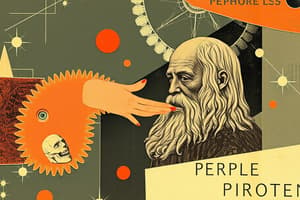Podcast
Questions and Answers
What role does enteropeptidase play in the activation of enzymes during digestion?
What role does enteropeptidase play in the activation of enzymes during digestion?
- It activates trypsinogen into trypsin. (correct)
- It neutralizes gastric acid in the duodenum.
- It hydrolyzes free amino acids into peptides.
- It facilitates the absorption of amino acids into the bloodstream.
Which of the following statements about the secretion of pancreatic proteases is accurate?
Which of the following statements about the secretion of pancreatic proteases is accurate?
- The secretion of proteases is unaffected by the concentration of intestinal amino acids.
- Pancreatic proteases are secreted in their active forms.
- CCK-PZ is involved in the regulation of pancreatic enzyme secretion. (correct)
- Secretin specifically stimulates the secretion of trypsinogen.
What function does bicarbonate (HCO3-) serve in the digestive process?
What function does bicarbonate (HCO3-) serve in the digestive process?
- It increases the acidity of the duodenum.
- It aids in the breakdown of peptides into amino acids.
- It activates pancreatic proteases upon entry into the duodenum.
- It neutralizes stomach acid to protect the intestinal lining. (correct)
Which sequence correctly describes the activation process of pancreatic protease?
Which sequence correctly describes the activation process of pancreatic protease?
Which component is primarily responsible for the secretion of pancreatic proteases?
Which component is primarily responsible for the secretion of pancreatic proteases?
Which enzyme is activated by enteropeptidase during the digestion process?
Which enzyme is activated by enteropeptidase during the digestion process?
What role does CCK-PZ play in the activation of pancreatic enzymes?
What role does CCK-PZ play in the activation of pancreatic enzymes?
What is the primary function of bicarbonate (HCO3-) released by pancreatic acinar cells?
What is the primary function of bicarbonate (HCO3-) released by pancreatic acinar cells?
Which of the following is a product of the autocatalysis of trypsin?
Which of the following is a product of the autocatalysis of trypsin?
Which enzyme is classified as an endopeptidase in the intestinal brush border?
Which enzyme is classified as an endopeptidase in the intestinal brush border?
Study Notes
Digestion of Proteins - Phase 2: Pancreatic Proteases
- Trypsinogen is released from pancreatic acinar cells.
- Trypsinogen autocatalyzes to form trypsin.
- Trypsin activates other pancreatic zymogens, chymotrypsinogen, proelastase, and procarboxypeptidases.
- Chymotrypsin, elastase, and carboxypeptidases are activated to break down proteins into smaller peptides.
- Duodenal cells release cholecystokinin-pancreozymin (CCK-PZ) in response to proteins in the duodenum.
- Duodenal and pancreatic cells secrete secretin in response to acid.
- Secretin stimulates the production of bicarbonate ions (HCO3-) in pancreatic juice, which neutralizes the acid from the stomach.
Digestion of Proteins - Phase 3: Brush Border
- Brush border enzymes, endopeptidases and aminopeptidases, hydrolyze peptides into amino acids.
- Amino acids, di-, tripeptides are absorbed into epithelial cells.
Digestion of Proteins - Phase 4: Absorption
- Na+-dependent co-transport and facilitated diffusion are involved in amino acid absorption.
- Dipeptides and tripeptides are absorbed from the intestinal lumen into intestinal epithelial cells via brush border.
- Dipeptidases and tripeptidases hydrolyze di- and tripeptides into amino acids.
Protein Turnover
- Proteins are constantly synthesized and broken down - Turnover
- The turnover rate depends on the protein type.
- Proteins with regulated concentrations (e.g. hormones) or that act as signals have a high turnover rate.
- Non-growing healthy adults with stable weight: Protein synthesis and breakdown are balanced - Nitrogen (N) Balance.
Measuring Protein Turnover
- N balance can be determined by examining the intake and output of nitrogen (measured by urinary urea nitrogen)
- Tracer methods like stable and radioactive tracers are used to determine amino acid kinetics.
- Isotopically labeled tracers are used to determine the rates of amino acid release from protein breakdown and the rates of amino acid uptake for protein synthesis.
Protein in Disease and Protein Controversies
- Disease (infection, burn, surgery, trauma): Body protein is mobilized for fuel and gluconeogenesis.
- Old and chronic illness: Protein loss increases due to increased metabolic rate.
- Supplementation with specific amino acids (e.g. glutamine, arginine) may be beneficial for specific conditions.
- High protein intake in individuals with renal failure can worsen their condition.
- High protein diet for weight loss: There are controversies about the effectiveness and safety of high protein diets.
- Protein intake and bone health: High protein intake may have negative effects on bone health.
Studying That Suits You
Use AI to generate personalized quizzes and flashcards to suit your learning preferences.
Related Documents
Description
This quiz covers the enzymatic digestion of proteins during the pancreatic phase. It includes the role of trypsin and other pancreatic proteases, the action of duodenal hormones, and the involvement of brush border enzymes in the absorption of amino acids. Test your understanding of these crucial biochemical processes.




